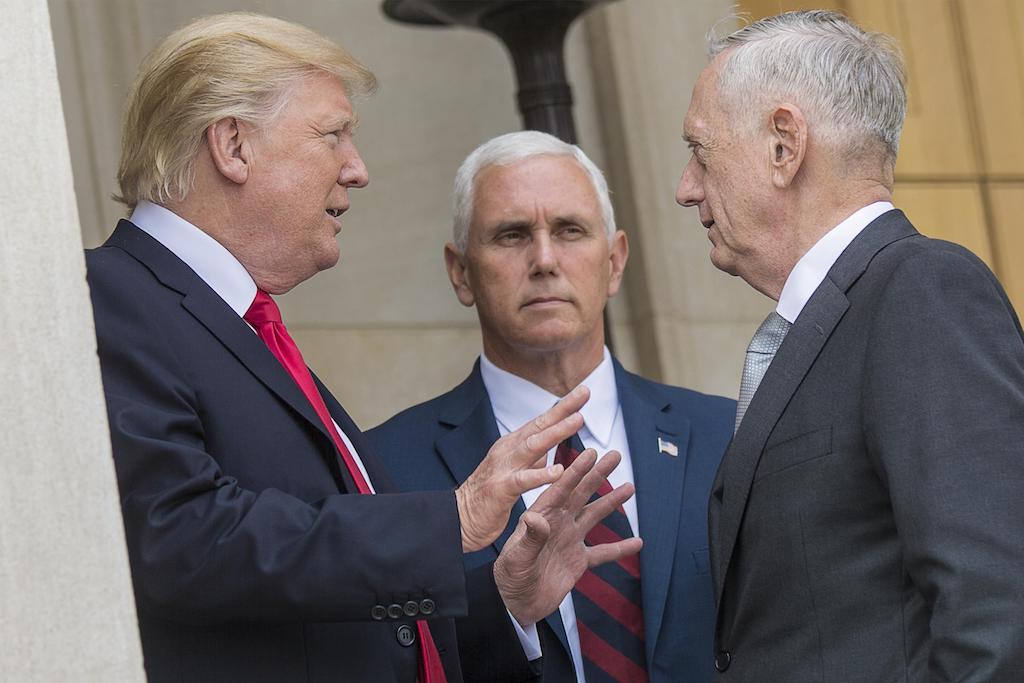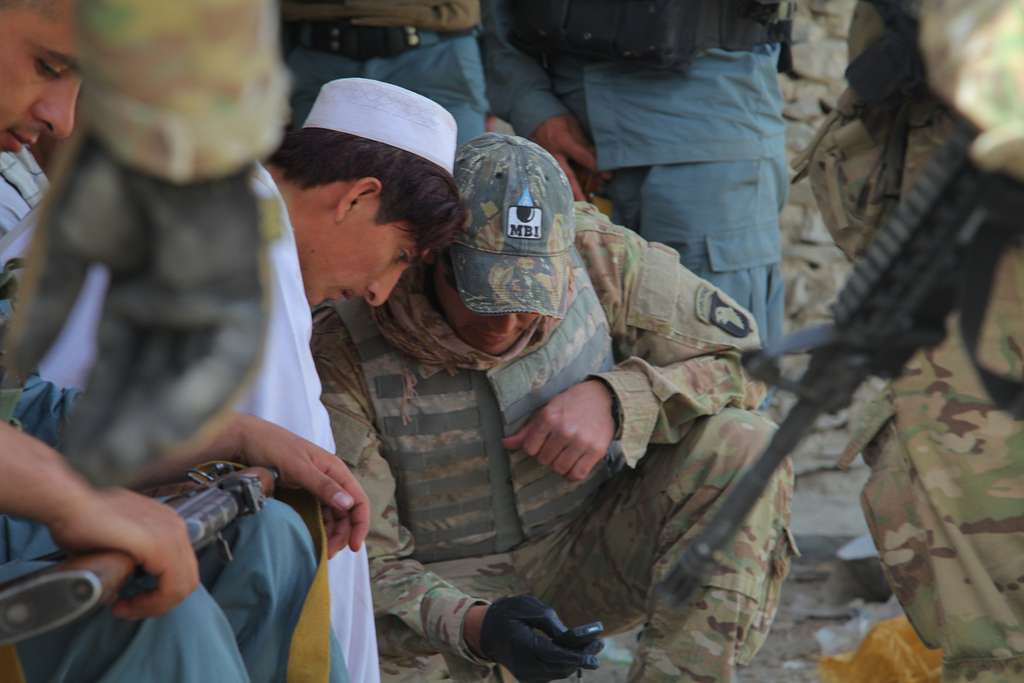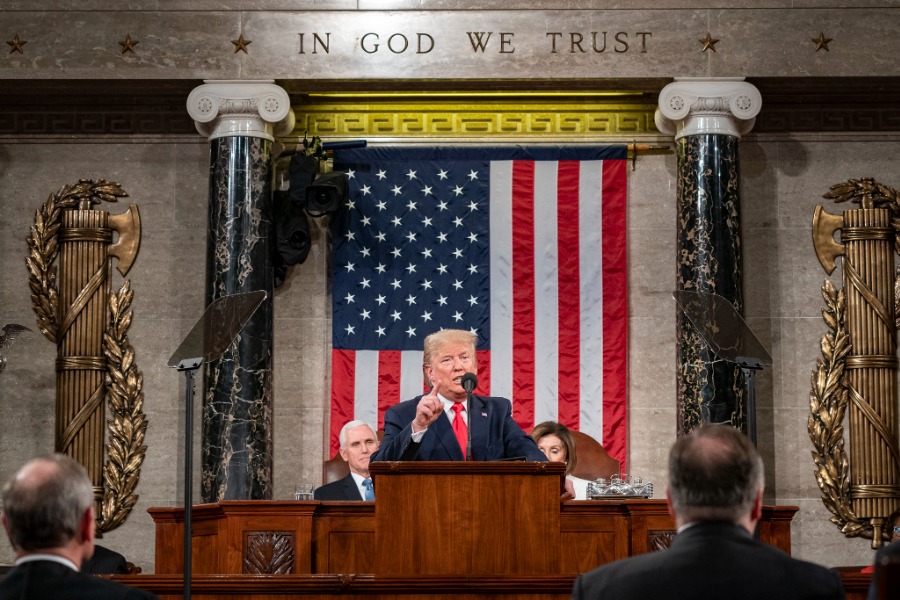We Read the New War Powers Report So You Don't Have To
Editor's note: Several hours after we published this post, the report described below became available online courtesy of The New York Times. The Times also provides more details on the previously undisclosed Dec. 6, 2017 attack in Niger noted briefly in the report and below: Nigerien and U.S.

Published by The Lawfare Institute
in Cooperation With

Editor's note: Several hours after we published this post, the report described below became available online courtesy of The New York Times. The Times also provides more details on the previously undisclosed Dec. 6, 2017 attack in Niger noted briefly in the report and below: Nigerien and U.S. troops, including Green Berets, came under fire from a group of fighters believed to be affiliated with the Islamic State. 11 of the fighters were killed in the firefight; no Nigerien or U.S. troops were hurt.
This past Monday, March 12, the Trump administration met its deadline to provide Congress with a “report on the legal and policy frameworks for the United States’ use of military force and related national security operations[,]”—a new requirement imposed by Section 1264 of the National Defense Authorization Act for fiscal year 2018 (since codified at 50 U.S.C. §1549). The NDAA requires the main body of the report to be unclassified. So while the statute only mandates that the administration hand over the report to the relevant congressional committees, observers had hoped that the Trump administration would follow the example set by its predecessor and publicly release its report.
As far as we can tell, that hasn’t happened yet. Instead, the White House has limited public disclosure of the report to a cover letter indicating that the document has been transmitted to Congress. But, over the course of the day on Tuesday, the congressional committees began to receive copies of the unclassified report. So, curious as to what it said, we decided to head down to Capitol Hill to review it in person, an underappreciated option for many congressional reports. While relevant committee rules did not allow us to make copies or take pictures of the report, we were able to spend a few hours with a hard copy.
Section 1264 only requires that the report identify and discuss changes from the similar report released voluntarily by the Obama administration in December 2016. The Trump administration’s report doesn’t go much beyond that requirement. A brief nine pages with a light scattering of footnotes, it largely confines itself to high-level discussion, though it does dig deeper into details in a handful of places. It also makes frequent reference to the fact that additional discussion and details are available in its classified annex, which (for obvious reasons) was not available for us to review.
In this sense, the Section 1264 report is likely to fall short of the detailed discussion for which many may have hoped. Nonetheless, it does give real insight on a number of important points. Perhaps the most surprising is an undisclosed—at least as far as we can tell—encounter between U.S. troops and enemy forces assessed to be part of the Islamic State in Iraq and Syria in Niger on or about Dec. 6, 2017, two full months after the tragic ambush that resulted in the deaths of four U.S. service members. The nature and significance of this encounter are unclear. But the fact that the report repeatedly cites it alongside the October 2017 ambush certainly stands out.
The remainder of this post summarizes what we read in the unclassified report. Though we have done our best to be accurate, there are almost certainly errors, as it is based on our notes alone; certainly, none of what we’ve written should be taken as a verbatim quote. Moreover, we’ve no doubt missed issues that are of interest to at least some readers. Nonetheless, we hope this will provide a useful overview for those who are not in a position to review a hard copy of the report themselves.
States Where the United States Has Used or Is Using Force
The report begins with a narrative description of the countries in which the United States has used or is currently using force. For the most part, this section excerpts from the country-by-country narratives in the most recent December 2017 periodic war powers report, specifically in entries relating to Afghanistan, Iraq and Syria, Yemen, Somalia, Libya, and Niger. There are, however, a few differences worth noting.
In regard to Yemen, the report explicitly asserts that U.S. support for the Saudi-led coalition fighting Houthi and Saleh-aligned forces in Yemen does not constitute “hostilities” for the purposes of the War Powers Resolution. This is consistent with the position that the Department of Defense has taken in recent congressional correspondence, as one of us has previously described.
In regard to Niger, the report reiterates the description of the Oct. 4, 2017, attack on U.S. forces provided in the December 2017 periodic war powers report, noting that U.S. forces deployed to Niger to train, advise, and assist Nigerien partner forces came under attack by elements assessed to be part of ISIS. As mentioned above, the report also references a similar incident on Dec. 6, which has not, to our knowledge, been previously reported. However, it provides no additional details, aside from noting elsewhere that U.S. forces responded in self-defense.
Legal Authorization
The report then describes the sources of legal authorization for U.S. military activities and relevant national security operations.
In regard to the 2001 authorization for use of military force (AUMF), the report doesn’t provide any additional information. Instead, it simply notes that the classified annex contains information regarding the application of the 2001 AUMF to specific groups and individuals.
In regard to the 2002 AUMF regarding Iraq, the report notes that it is not implementing any changes to the original report’s interpretation or use of this authority, but wishes to provide a fuller explanation. In doing so, it largely paraphrases the analysis presented by Acting General Counsel for the Department of Defense William Castle in a set of December 2017 remarks. While the 2002 AUMF was originally intended to address the threat posed by the Saddam Hussein regime, it asserts, the United States has since relied on it to authorize operations against al-Qaeda in Iraq—which later became ISIS—for several years, an understanding that Congress tacitly ratified through appropriations. It also notes that the 2002 AUMF, like the 2001 AUMF, does not have any specific geographic limitations, though uses of force it authorizes must be tied to threats from or to Iraq.
Finally, the report addresses the scope of the president’s Article II authority, reasserting that the president has the constitutional authority to use military force in certain circumstances even without the specific prior authorization of Congress. While it does not elaborate on this position further, the report does provide a specific example: the April 2017 airstrikes on Shayrat airbase in Syria. According to the report, the president authorized those strikes based on intelligence reports concluding that the Syrian military forces that had used chemical weapons against Syrian civilians were operating out of Shayrat, in hopes of both degrading their ability to pursue further attacks and dissuading them from doing so. Repeating language from President Trump’s original notification to Congress, the report goes on to assert that the president deemed this action to be in the vital national security and foreign policy interests of the United States and pursued it under his Article II authority to conduct foreign relations and as commander in chief and chief executive.
Working with Others in an Armed Conflict
The report then addresses certain legal issues relating to cooperation with foreign states and other entities in national security operations. It notes that the 2017 National Security Strategy and 2018 National Defense Strategy both prioritize working with allies and partners. As an example, it cites the “Defeat-ISIS” coalition, which it notes includes over 70 states, four international organizations, and an array of nonstate actors, all of whom have proven critical in dismantling ISIS’s self-proclaimed physical “caliphate.”
The report then comments on a statutory provision—specifically, Section 1232 of the 2017 NDAA, as amended by Section 1231 of the 2018 NDAA—that purports to limit the use of funds for any bilateral military-to-military cooperation with Russia until Russia ceases its occupation of and hostility towards Ukraine, among other measures. The report accepts many such limitations but expresses the view that this restriction does not prohibit discussions with Russia for the purposes of deconflicting military operations in Syria in order to reduce the risk of interference, miscalculation or unintended escalation of military operations there.
Finally, the report provides a statement on U.S. intelligence-sharing policies. Specifically, it notes that the United States often supports its partners and allies by providing intelligence in furtherance of shared objectives, and as a result takes various measures—including diplomatic assurances, vetting, training and monitoring—to promote respect for human rights, ensure that the recipient of the intelligence complies with the law of armed conflict and mitigate any risk that the intelligence will be used in violation of the law. Further, it asserts that sharing must always be consistent with U.S. domestic law.
Application of Key Domestic and International Legal Principles to Key Theaters
The report then addresses how the legal authorities described previously apply in various key theaters. The theaters described are the same ones discussed earlier in the report— namely Afghanistan, Iraq, Syria, Yemen, Somalia, Libya and Niger—and the descriptions reiterate much of the same information previously taken from the December 2017 periodic war powers report. In almost every case, the report also notes that the domestic and international legal bases for these actions remain unchanged from the Obama administration’s December 2016 framework report, and that the United States is continuing to pursue these activities under authorities provided by statute and the Constitution without further specification.
In regard to Iraq, the report also notes that, due to accelerated progress in the fight to defeat ISIS, the United States and coalition partners are shifting their focus toward sustaining military gains. While the coalition remains engaged in offensive operations against ISIS, this shift incorporates a greater amount of advising and coordinating with Iraqi forces to prevent ISIS from re-emerging. The coalition will also focus on training, equipping, and building the capacity of elements of the Iraqi security forces and peshmerga. The report specifically cites Section 1222 of the 2018 NDAA—which authorizes counter-ISIS assistance—as statutory authorization for many of these activities.
In regard to Syria, the report notes that U.S. and coalition forces are continuing to support the Syrian Democratic Forces in liberating the Middle Euphrates River Valley from ISIS. Its activities include airstrikes, advice to and coordination with indigenous ground forces, along with the training and equipping of those indigenous forces. It specifically cites Section 1223 of the 2018 NDAA—which authorizes the “train and equip” program for certain Syrian rebel groups—as statutory authorization for some of these activities. The report also notes that ISIS continues to be able to carry out lethal attacks, and that as a result U.S. uses of force against ISIS and al-Qaeda will also continue. It further notes that ISIS and al-Qaeda remain regional and global threats, including directly to the United States.
The report then specifically addresses the U.S. strikes on Syrian government and related forces that took place in May and June 2017 and February 2018. The report describes these strikes as limited and lawful measures taken to counter immediate threats to U.S. or partner forces while engaged in the campaign against ISIS. It asserts that the 2001 AUMF provides the authority to use force to defend U.S., coalition and partner forces engaged in the campaign to defeat ISIS to the extent such use of force is a necessary and appropriate measure in support of counter-ISIS operations. This is consistent with the views put forward by Defense Department and State Department in recent congressional correspondence. The report also notes that, as a matter of international law, the necessary and proportionate use of force in national and collective self-defense against ISIS in Syria includes similar defensive measures.
In regard to Yemen, the report writes that the 2001 AUMF authorizes activities against both al-Qaeda in the Arabian Peninsula and ISIS. Further, it provides some additional details on the limited support the United States provides to the Saudi-led coalition in Yemen. Specifically, it notes that this support includes intelligence sharing, best practices, and other advisory support when requested and appropriate. In addition, it identifies the Arms Export Control Act and the related Foreign Military Sales and Direct Commercial Sales programs as providing the domestic legal and policy framework for providing or licensing defense articles and services to the Saudi-led coalition.
In regard to Somalia, the report notes that the United States has undertaken activities targeting al-Qaeda, al-Shabaab, and more recently ISIS. It specifically notes that actions against ISIS have been undertaken with the consent of the Somali government in the context of both its own armed conflict with ISIS and U.S. national self-defense.
Finally, in regard to Niger, the report notes that, at the request of the Nigerien government, the Obama administration initially approved and the Trump administration continued the deployment of U.S. forces there under the president’s authority as commander in chief and chief executive and pursuant to relevant train and equip statutory authorities. It further notes that U.S. forces responded in self-defense to the Oct. 4 and Dec. 6, 2017, attacks described above, which were perpetrated by enemy forces assessed to be a part of ISIS and thus within the scope of the 2001 AUMF.
Targeting
The report then discusses issues of targeting. It notes that the United States remains committed to complying with the law of armed conflict and protecting civilians. Such conduct is consistent, it notes, both with domestic law constraints and often with mission success. Consequently, the report asserts that the United States continues, as a matter of policy, to apply heightened targeting standards that are more protective of civilians than is required under the law of armed conflict. These standards are reflected in presidential and executive branch policies, military orders and rules of engagement, and the training of U.S. personnel. The report notes that additional information on these measures is contained in the classified annex.
Capture and Detention of Individuals in Armed Conflict
The report then addresses the issue of detention, which, it asserts, remains an essential part of U.S. counterterrorism strategy. According to the report, the United States uses all available tools—including detention under the law of armed conflict, prosecution through the criminal justice system and transfer to third-party countries—in handling captured enemy forces, with the goals of maximizing intelligence collection and establishing an appropriate long-term disposition. It notes that the classified annex has additional information on this topic.
The report goes on to discuss various provisions in Executive Order 13823, which President Trump signed on Jan. 30. It specifically notes that this executive order directs the secretary of defense to develop new policy proposals for the use of detention, including the facilities at Guantanamo Bay, and indicates that the executive branch will keep Congress informed of any resulting changes in policy.
The report also discusses detention without statutory authorization. Specifically, it reiterates the view that the Constitution authorizes the president to engage in the use of force without specific prior congressional authorization in certain circumstances. It describes this as a “historical gloss” on Article II, citing the Supreme Court’s 2003 decision in American Insurance Association v. Garamendi. The report further asserts that this constitutional authority includes the authority to detain enemy forces, and cites the Supreme Court’s 2004 decision in Hamdi v. Rumsfeld—as well as Justice Clarence Thomas’s dissent—as support. This discussion largely parallels positions that the Justice Department has recently taken in the matter of Doe v. Mattis.
Finally, the report notes that Executive Order 13823 leaves in place review procedures for individuals detained at Guantanamo Bay. These procedures—an apparent reference to the Periodic Review Board system—ensure that the detention of those individuals continues to be necessary for U.S. national security interests.
Prosecution of Individuals Through the Criminal Justice System and Military Commissions
The report closes with a brief discussion of the fact that the United States continues to criminally prosecute certain terrorism suspects through the civilian criminal justice system and to try others through the military commissions. It specifically notes two recent successful prosecutions in federal criminal courts, namely those of Spin Ghul and Abu Khattala.
What’s Missing?
No one would describe this report as over-inclusive. There are several seemingly pertinent topics that it does not address, some of which have been flagged previously. Perhaps the most notable of these is the question of the president’s authority to use force against North Korea, something that has reportedly been the topic of extensive internal discussion within the Trump administration. As this issue was not covered in the original December 2016 report, the Trump administration may take the view that it is outside the scope of the Section 1264 requirement. Such context-specific parsing, however, would seem to run contrary to Section 1264’s intended purpose of providing an understanding of the executive branch’s views regarding its legal authority to use military force (among other items). Alternatively, it may simply reflect the fact that the Trump administration has reached no firm conclusions regarding relevant legal authorities.
Even where the report does provide information, it rarely does so with much detail. The report repeatedly references “constitutional authority” or “statutory authority” without articulating a specific argument or pointing to specific statutory provisions, sometimes making it difficult to discern the actual contours of the executive branch’s legal positions. And where the report lays out a general framework or set of policy priorities, it rarely gives much insight into how they apply in specific circumstances.
Much of this information may be contained in the report’s classified annex, and is at least available to Congress, if not the public. Yet this is hardly a satisfying alternative. While Section 1264 allows for the use of a classified annex, it requires that the report itself be unclassified and thus available to the public—if not directly, then through the Freedom of Information Act and other measures (including in-person review as we pursued). And while certain relevant facts may be classified, legal arguments themselves generally are not. Placing the latter into the classified annex where they can be segregated from the former would only undermine Section 1264’s intended purpose of promoting meaningful transparency, allowing the exception to swallow the rule. Hence, we hope that Congress will closely scrutinize the classified annex and push for further disclosures where appropriate.
Why Hide It?
Even setting aside the above, we’re left with another question: Why has the Trump administration decided not to make this report more easily available to the public? The document is public, but only available to those who have the time to make the trek to Capitol Hill. In contrast, the Obama administration chose to release its December 2016 report online in hopes of maximizing Americans’ ability to access it, a precedent that Section 1264 seems to endorse, if not require. Further, the Trump administration’s report for the most part just excerpts or paraphrases prior public statements that it has made through remarks, reports, congressional correspondence and litigation briefs, often in more summary form and with fewer details. Releasing such a report online would seem to cost the Trump administration next to nothing while signaling at least some recognition of the importance of transparency and the opportunity for a public debate on such important questions. This could in turn help assuage concerns that the Trump administration is embracing broad conceptions of executive power or otherwise departing from established practice in its use of force. Limiting access to the report, meanwhile, only leaves more space for these concerns and criticisms to take root.
While we can only speculate as to the Trump administration’s motivations, we sincerely hope they will reconsider. Not all Americans are in the position to review a hard copy in person as we have, and second-hand summaries such as this one are poor substitutes. Making this and future reports more readily available to the public will better serve both the purposes of Section 1264 and the principles of our democratic system as a whole. And if the Trump administration chooses not to do so, we hope that Congress will consider strengthening Section 1264’s transparency and disclosure requirements going forward.






